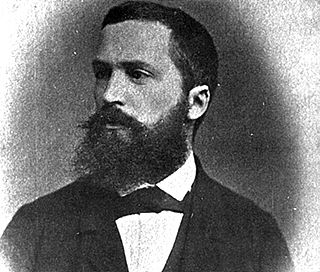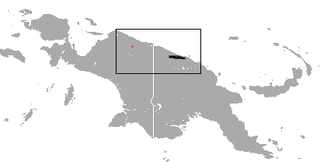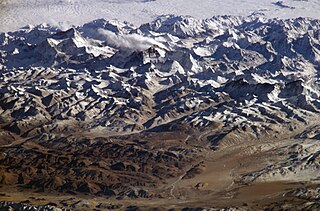
The Gulf of Guinea is the northeasternmost part of the tropical Atlantic Ocean between Cape Lopez in Gabon, north and west to Cape Palmas in Liberia. The intersection of the Equator and Prime Meridian is in the gulf.

Friedrich Hermann Otto Finsch was a German ethnographer, naturalist and colonial explorer.

Kaiser-Wilhelmsland formed part of German New Guinea, the South Pacific protectorate of the German Empire. Named in honour of Wilhelm I, who reigned as German Emperor (Kaiser) from 1871 to 1888, it included the northern part of present-day Papua New Guinea. From 1884 until 1920 the territory was a protectorate of the German Empire. Kaiser-Wilhelmsland, the Bismarck Archipelago, the northern Solomon Islands, the Caroline Islands, Palau, Nauru, the Mariana Islands, and the Marshall Islands comprised German New Guinea.

The German New Guinea Company was a German Chartered Company which exploited insular territory in and near present Papua New Guinea.
Ferdinand von Hansemann (1861-1900) was a Prussian landlord and politician, co-founder of the German Eastern Marches Society.

Morobe Province is a province on the northern coast of Papua New Guinea. The provincial capital, and largest city, is Lae. The province covers 33,705 km², with a population of 674,810, and since the division of Southern Highlands Province in May 2012 it is the most populous province. It includes the Huon Peninsula, the Markham River, and delta, and coastal territories along the Huon Gulf. The province has nine administrative districts, and 101 languages are spoken, including Kâte and Yabim. English and Tok Pisin are common languages in the urban areas, and in some areas forms of Pidgin German are mixed with the native language.

The Bird's Head Peninsula or Doberai Peninsula is a large peninsula that makes up the northwest portion of the island of New Guinea and the major part of the Province of West Papua, Indonesia. The other edge is on the Bird's Tail Peninsula.

The golden-mantled tree-kangaroo is a species of tree-kangaroo endemic to the Northern New Guinea montane rain forests ecoregion of northern New Guinea island.

David Justus Ludwig Hansemann was a Prussian politician and banker, serving as the Prussian Minister of Finance in 1848.

The New Guinea Highlands, also known as the Central Range or Central Cordillera, are a chain of mountain ranges and intermountain river valleys, many of which support thriving agricultural communities, on the large island of New Guinea. The highlands run generally east-west the length of the island, which is divided politically between Indonesia in the west and Papua New Guinea in the east.
The Hanseman languages are a group of relatively closely related languages in New Guinea. "Closely related" is relative to the situation in New Guinea. Ethnologue notes that Wagi, for example, may be most closely related to Nobonob, yet they are only 30% lexically similar.

New Guinea is a large island separated by a shallow sea from the rest of the Australian continent. It is the world's second-largest island, after Greenland, covering a land area of 785,753 km2 (303,381 sq mi), and the largest wholly or partly within the Southern Hemisphere and Oceania.
David Paul von Hansemann was a German pathologist born in Eupen. He is remembered for his work in the field of oncology, in particular, his concept pertaining to anaplasia of cancer cells.
The Astrolabe Company was a German "colonial society" (Kolonialgesellschaft) in Kaiser-Wilhelmsland, which existed from 1891 to 1896. On 27 October 1891 it was founded with a capital of 2.4 million marks. Involved were Hamburg and Bremen notables and the financiers.

Puncak Jaya or Carstensz Pyramid (4,884 m [16,024 ft]) is the highest summit of Mount Jayawijaya or Mount Carstensz in the Sudirman Range of the western central highlands of Papua Province, Indonesia. Other summits are East Carstensz Peak (4,808 m [15,774 ft]), Sumantri (4,870 m [15,980 ft]) and Ngga Pulu (4,863 m [15,955 ft]). Other names include Nemangkawi in the Amungkal language, Carstensz Toppen and Gunung Soekarno.
Johann Wilhelm Adolf Hansemann was a German entomologist and insect dealer.

Ottilie von Hansemann was a German women's rights activist, significant patroness of the women's movement in Prussia, and a champion for the right of women to attend German universities, to participate in university classes alongside their male cohorts, and to live in student residence halls built specifically for female students.















